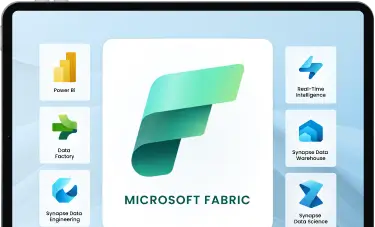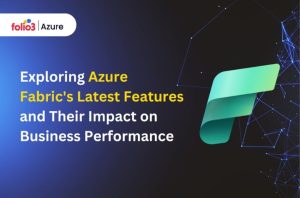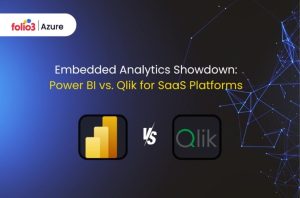Table of Contents
ToggleLike our cosmos, our world dwells on the solid pillars of data. Data and insights are the driving force behind the wheels of the world’s economy. Thus, expert data management and insightful analytics are the bedrock for intelligent business decisions.
Microsoft Fabric plays a critical role in enriching Power BI reporting and analytics, providing advanced features that tackle the multifaceted needs of modern enterprises. By utilizing Fabric for PowerBI reporting, you can use powerful features that transform raw data into actionable insights, ensuring your organization outperforms amidst intense competition.
Accelerate smart decisions with Microsoft Fabric's unified data and AI analytics.

Benefits of Using Microsoft Fabric with Power BI
Power BI and Microsoft Fabric integration form a powerful duo with a myriad of advantages. Let’s discuss them in more detail.
1. Enhanced Data Management
One of the dominant benefits of Power BI and Microsoft Fabric integration is its capacity to simplify and organize data management processes. Microsoft Fabric improves data preparation, ensuring that your data is ready for advanced analytics within Power BI.
By using Fabric for PowerBI reporting, you can quickly and efficiently manage massive amounts of data, making it easier to filter, organize, and analyze. This integration simplifies data handling and assures that your reports are based on the most accurate and up-to-date information.
2. Improved Data Connectivity
Seamless data connectivity is the key to enhancing Power BI reports, which leads to quick reporting and analytics. With Microsoft Fabric, you can smoothly merge data from various sources into Power BI, ensuring that your reports are complete and a clear reflection of your entire data.
The Power BI and Microsoft Fabric integration facilitates painless data synchronization, making gathering information from different platforms easier. This high level of interconnectivity boosts the quality of your Power BI reports, providing a panoramic view of your business operations.
3. Scalability and Performance
The volume of data you need to manage and your organization grow hand in hand. Microsoft Fabric provides scalable solutions that future-proof you by guaranteeing your Power BI reports can handle large datasets without affecting performance.
Whether you’re handling millions of records or complex data structures, employing Fabric for PowerBI reporting ensures that your analytics remain swift and responsive. The scalability provided by Microsoft Fabric also means that your Power BI environment can grow simultaneously with your business and adapt to increasing data demands easily.
4. Advanced Analytics Capabilities
With the help of Microsoft Fabric, Power BI users can easily carry out complex computations and predictive analytics. You may use advanced analytical capabilities that go beyond simple reporting by integrating Fabric for PowerBI reporting.
These abilities enable you to develop more intelligent business plans, find profound insights, and create more accurate predictions. Using Microsoft Fabric, your Power BI reports produce practical information that accelerates success rather than merely displaying facts.
Key Features of Microsoft Fabric for Power BI Reporting
Let’s go through the dominant features of Microsoft Fabric for Power BI Reporting to gain a deeper understanding.
1. Data Preparation and Transformation
Dataflows and Data Transformation
Meticulous data preparation is the basis for creating and generating accurate and meaningful reports. Microsoft Fabric comes with powerful dataflows and transformation features that make it simple to prepare your data for analysis in Power BI.
These tools enable you to clean, structure, and refine your data before visualizing it in Power BI. This is a crucial step towards ensuring that your reports are created based on high-quality information.
By taking advantage of Fabric for PowerBI reporting, you can simplify the data preparation processes, leading to more reliable and valuable information.
Data Modeling and Schema Management
Data modeling and schema management are indispensable elements of Power BI reporting. Microsoft Fabric improves and eases these processes by providing solid tools for managing data schemas and enhancing data models.
By employing Fabric for PowerBI reporting, you can ensure that your data is organized to make efficient analysis and reporting possible. Accurate data modeling improves report performance and makes it easier to maintain data solidarity across your organization.
2. Real-Time Data Processing
Real-time data processing is requisite for making timely decisions and being highly responsive in today’s dynamic business sector. Microsoft Fabric aids real-time data processing, empowering you to create live Power BI dashboards that show the most recent data.
This feature is especially valuable for organizations that need to monitor operations in real time, as it ensures that your Power BI reports are always up to date. By using Fabric to Enhance Power BI reports, you can keep your finger on the pulse of your business and monitor all the vital signs.
3. Data Integration and Connectivity
Connecting to Various Data Sources
Microsoft Fabric outshines its capability to connect to a wide variety of data sources, making it a multi-purpose tool for enhancing Power BI reports. Whether your data is stored in cloud-based platforms, on-premises databases, or third-party applications, Fabric for PowerBI reporting makes it a breeze to merge and analyze this data within Power BI.
This high level of flexibility guarantees that you can produce comprehensive reports integrating information from all areas of your company, giving you a complete picture of how well your firm is performing.
Data Synchronization
Data synchronization in Power BI and Microsoft Fabric is smooth, ensuring that your reports are always based on the most up-to-date information. This ability is of immense importance for organizations that function in shifting environments where data changes quickly.
By using Fabric for PowerBI reporting, you can ensure that your Power BI dashboards and reports are constantly updated, minimizing the risk of making decisions based on obsolete information.
4. Advanced Security and Compliance
Security is of the utmost importance and the top priority when handling sensitive business data. Microsoft Fabric equips you with solid security features and compliance options that provide secure Power BI reporting.
Whether dealing with financial data, customer information, or proprietary business metrics, Fabric for PowerBI reporting guarantees that your data is always safeguarded. These strong security features include encryption, access controls, and adherence to industry standards.
Accelerate smart decisions with Microsoft Fabric's unified data and AI analytics.

Best Practices for Leveraging Microsoft Fabric with Power BI
Specific best practices can be taken advantage of when using fabric for PowerBi reporting.
These include the following:
1. Optimizing Data Models for Power BI
To reap the maximum benefits of Power BI, it’s critical to refine and enhance your data models for effective analysis. Microsoft Fabric equips you with smart tools that make it easier to design and maintain optimized data models.
By utilizing Fabric for PowerBI reporting, you can create efficient and scalable data models. This leads to responsive reports in the future when your data grows. Properly optimized data models also lead to faster report performance and better data quality.
2. Enhancing Report Performance
Report performance is a significant factor in ensuring that your Power BI dashboards and reports are helpful and also user-friendly. Microsoft Fabric is embedded with numerous features that can help you boost the performance of Power BI reports.
These include data caching, query optimization, and real-time processing capabilities. By using Fabric for PowerBI reporting, you can ensure that your reports load promptly and deliver accurate insights, even when dealing with large datasets or complex queries.
3. Ensuring Data Quality and Consistency
In order to generate reliable Power BI reports, high data quality and consistency are a must-have. Microsoft Fabric is embedded with tools that help you maintain data quality by ensuring that your data is clean, accurate, and up to date.
The data consistency feature is also supported by Fabric for PowerBI reporting, which ensures that data from different sources is the same and integrated quickly. By adhering to best practices for data quality and consistency, you can create Power BI reports that are reliable and highly informational.
4. Utilizing Advanced Features
Microsoft Fabric furnishes many advanced features that can uplift your Power BI reports to the next level. These modern features include AI-powered analytics, advanced data visualization options, and predictive modeling tools.
By taking advantage of these features within Fabric for PowerBI reporting, you can create reports that not only present data but also provide deep knowledge and actionable advice. Making use of these latest features ensures that your Power BI environment is fully equipped to meet the needs of your business.
Conclusion
Leveraging Microsoft Fabric for advanced Power BI reporting and analytics provides your organization with strong tools to manage data, increase connectivity, and boost performance.
By adhering to the recommended best practices and fully benefiting from Microsoft Fabric’s capabilities, you can revamp your Power BI environment into a solid platform for data-led decision-making.
As you consider integrating Microsoft Fabric into your Power BI, it’s beneficial to collaborate with experts who can guide you through the process and ensure that you’re maximizing the potential of these powerful tools.
Our team at Folio3 specializes in Microsoft Fabric services, helping organizations like yours enhance their reporting and analytics capabilities.


